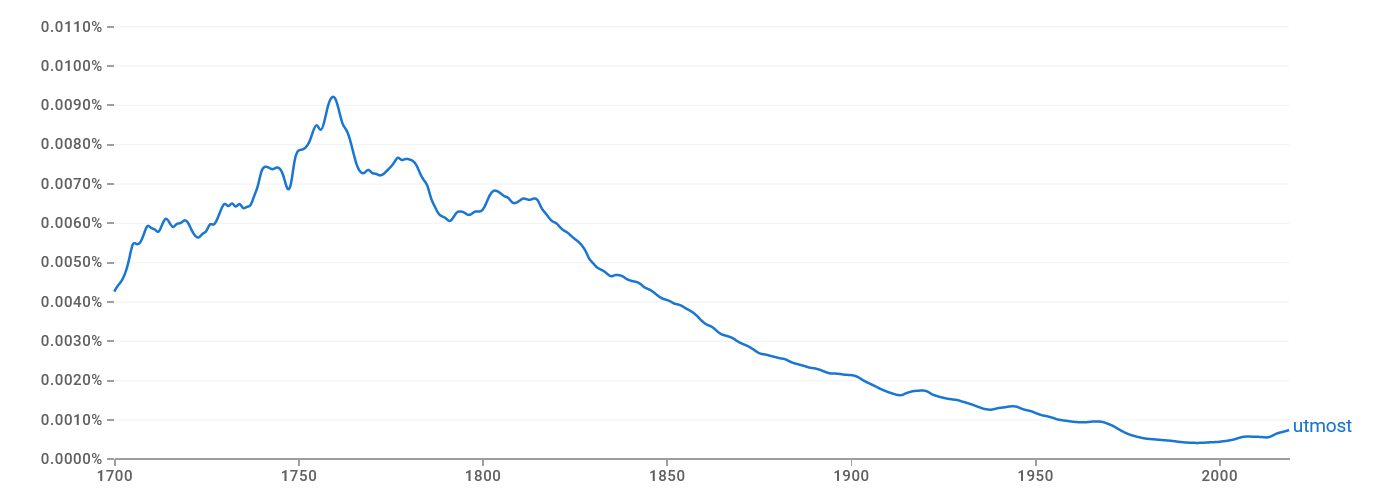
Ernest Davis
September 17, 2023.
Most direction words in English form their superlatives with the suffix "-most" rather than "-est".
Below I display the Google NGrams plot of the frequency of these various words in the period 1700-2019, together with the first usage recorded in the Oxford English dictionary. Some of these I find surprising or interesting. I don't have any theories to explain any of these:
IMPORTANT: The y-axes in these plots have different scales, ranging from 1 vertical unit = 0.001% = 10-5in the plot of "utmost" to 1 vertical unit = 0.0000002% = 2*10-9 for the plot of "forwardmost, dorsalmost, ventralmost". That is, if the graph for "forwardmost" were printed to be 4 inches tall, and the curve for "utmost" were added to scale, it would be 50 yards away.
The Google Ngram plots are done with the default 3-year smoothing.
I have organized these plots by semantic category. The categories are ordered in approximate decreasing order of frequency of the most common word. Within each category, they are ordered by decreasing frequency. together semantically related words.
Obviously minor differences in spelling e.g. "easternmost" with an `n' vs. "eastermost" without an `n' are of little to no significance in the ear1y 18th century and of not great significance afterwards. However, since both the OED and Google NGram distinguish these, it is easiest to follow their leads. In a few instances, the OED conflates two spellings that Google NGram distinguished; e.g. "north-easternmost" vs. "northeasternmoat"
This is the category I find most intriguing. Why did "innermost" and "outermost" replace "inmost" and "outmost"? Why has "inmost" declined by a factor of 5 since 1850? Why does English need two forms of "inmost" and four forms of "outmost/utmost"?
Interestingly the earliest attested uses of both "inmost" and "innermost" are both in the metaphorical sense of "deepest thoughts" rather than in a literal meaning.

Y-axis: 1 vertical unit = 0.001% = 10-5
First usage (OED): Old English.
Note that etymologically, "utmost" is just a variant of "outmost". It is by a large margin the most common in this list, though its popularity has declined by a factor of 12 since 1859.
************************************************************************
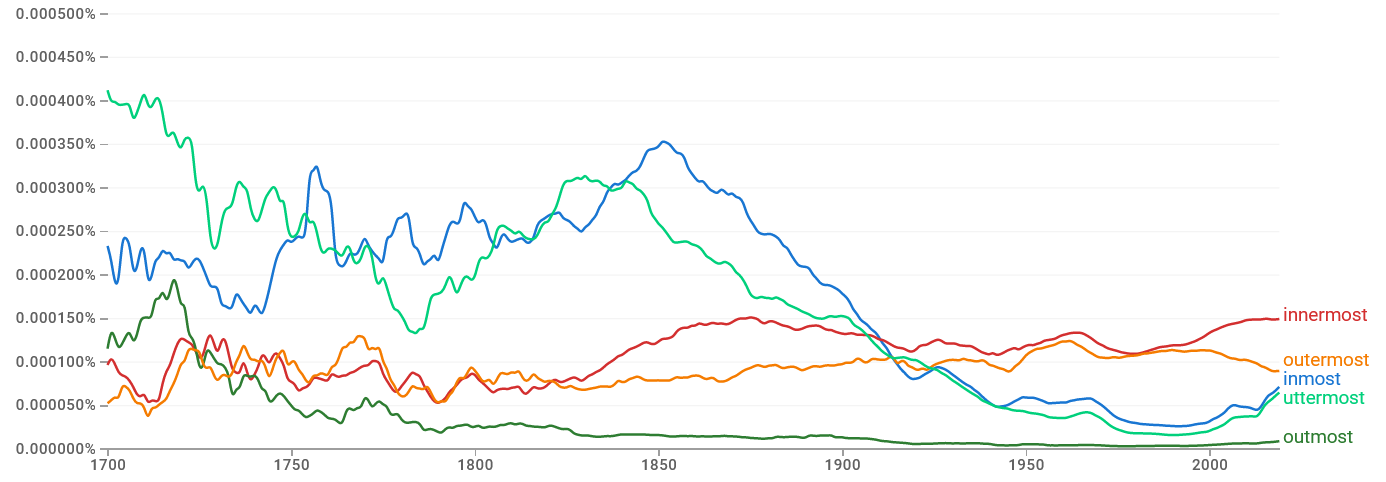
Y-axis: 1 vertical unit = 0.00005% = 5*10-7
First usage (OED): "inmost" Old English; "outmost" 1382; "uttermost" 1382; "innermost" 1413; "outermost" 1587.
************************************************************************
************************************************************************
************************************************************************

Y-axis: 1 vertical unit = 0.0001% = 10-6
First usage (OED): "foremost" Old English.
************************************************************************

Y-axis: 1 vertical unit = 0.00001% = 10-7
First usage (OED): "hindermost" 1398. "hindmost" 1487.
I don't think I have ever heard the word "hindmost" except as part of the phrase "devil take the hindmost". I've never heard "hindermost" at all.
************************************************************************
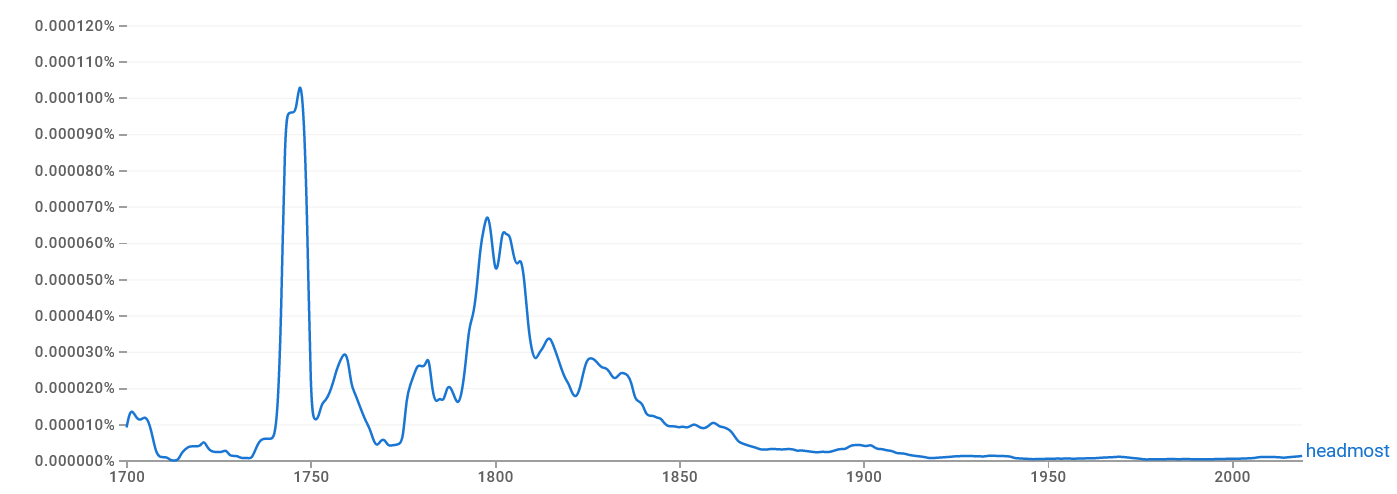
Y-axis: 1 vertical unit = 0.00001% = 10-7
First usage (OED): "headmost" 1592.
************************************************************************
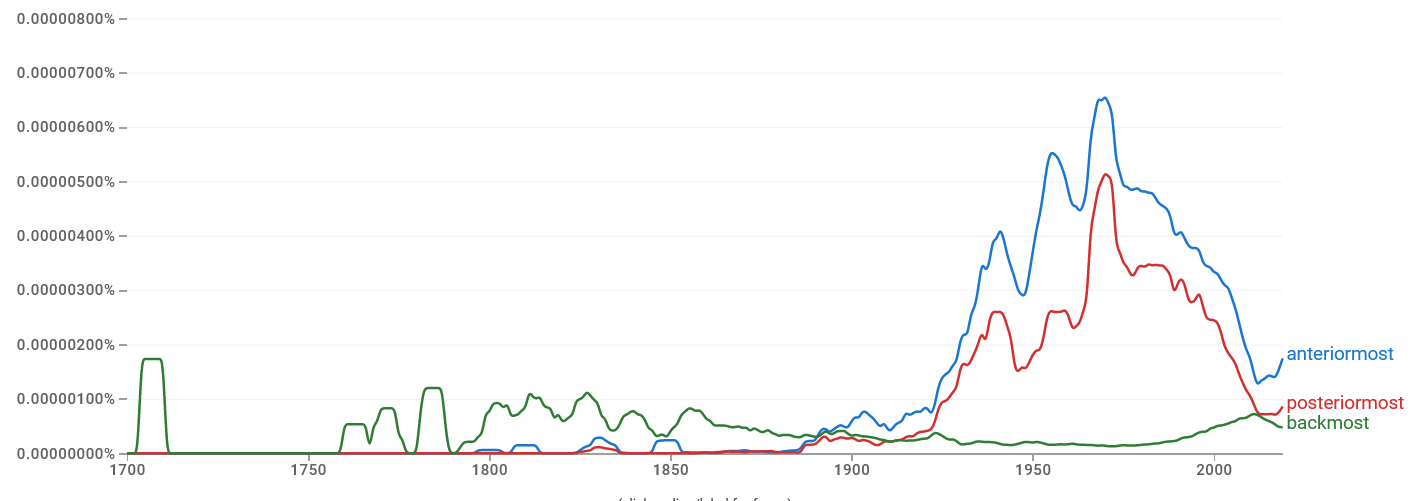
Y-axis: 1 vertical unit = 0.000001% = 10-8
First usage (OED): "backmost" 1782; "anteriormost" 1826; "posteriormost" 1906
************************************************************************

Y-axis: 1 vertical unit = 0.0000002% = 2*10-9
First usage (OED): "forwardmost" 1795; "dorsalmost" 1883; "ventralmost" not recorded in the OED, but it appears in Google Books from 1888.
************************************************************************
************************************************************************
************************************************************************

Y-axis: 1 vertical unit = 0.00005% = 5*10-7
First usage (OED): "uppermost" 1481; "topmost" 1613.
Go figure. By contrast, "top" and "upper" were more or less equally popular until about 1935; then "top" pulled somewhat ahead, and in 1975 "top" was about 20% more popular. Since then, however, "top" has shot ahead and "upper" has declined, so that "top" is now more than 2-1/2 times more frequent.
************************************************************************
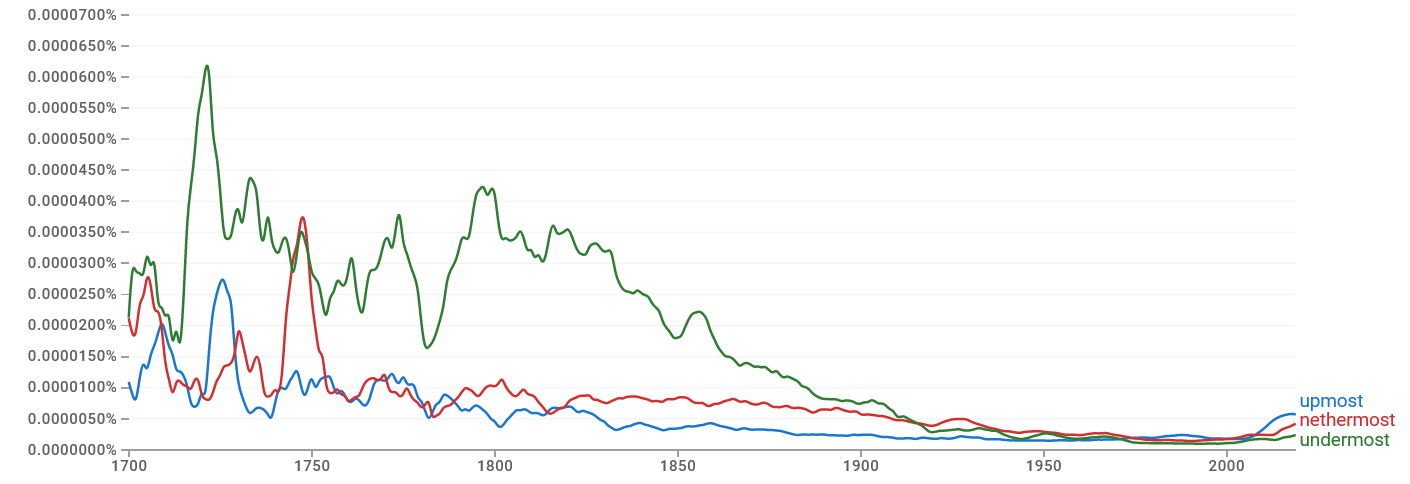
Y-axis: 1 vertical unit = 0.000005% = 5*10-8
First usage (OED): "nethermost" 1387; "upmost" 1488; "undermost" 1555
************************************************************************
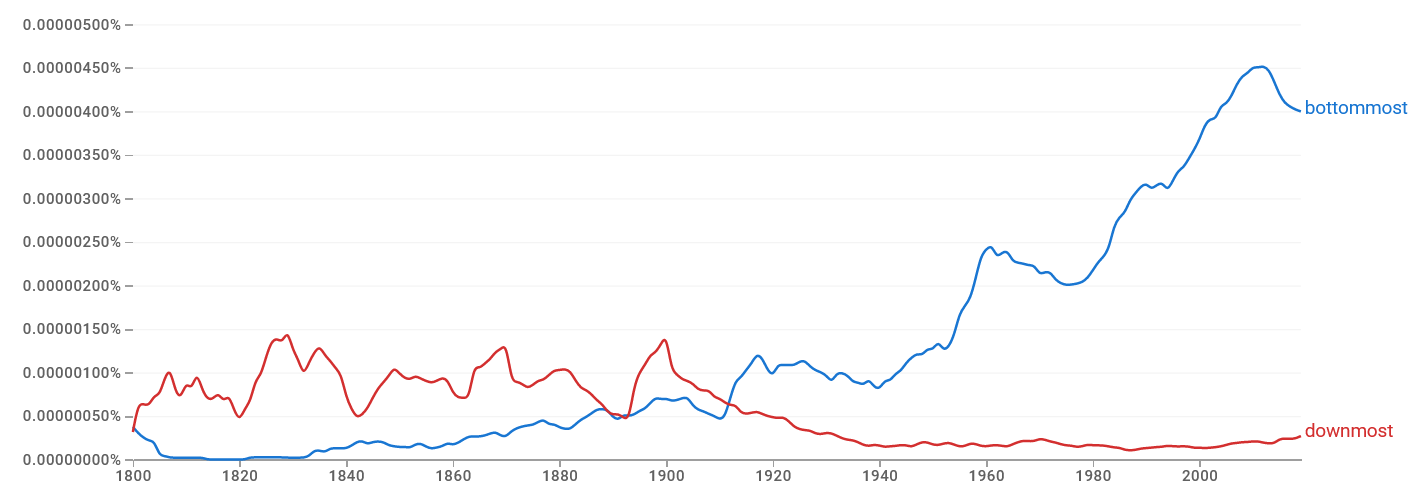
Y-axis: 1 vertical unit = 0.0000005% = 5*10-9
First usage (OED): "downmost" 1600;" bottommost" 1694.
************************************************************************
************************************************************************
************************************************************************
There are two mysteries here. First, in the 18th and early 19th centuries the four terms are pretty much equal with random variation, as one would expect, but from 1850 on, "northernmost" and "southernmost" are definitively more common than "easternmost" and "westernmost", reaching about double the frequency in 1950. Why? Second, why did these terms replace the earlier "northmost" etc.?
************************************************************************

Y-axis: 1 vertical unit = 0.00001% = 10-7
First usage (OED): "westernmost" 1589; "southernmost" 1591; "easternmost" 1631; "northernmost" 1661.
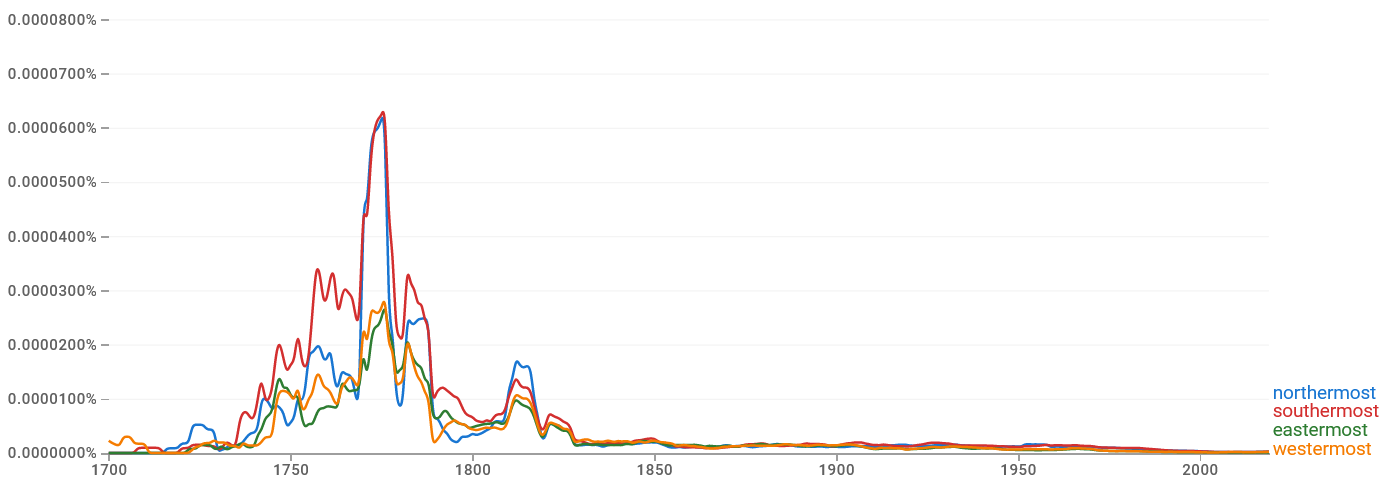
Y-axis: 1 vertical unit = 0.00001% = 10-7
First usage (OED): "westermost" 1435; "southermost" 1555; "eastermost" 1555; "northermost" 1572.
************************************************************************
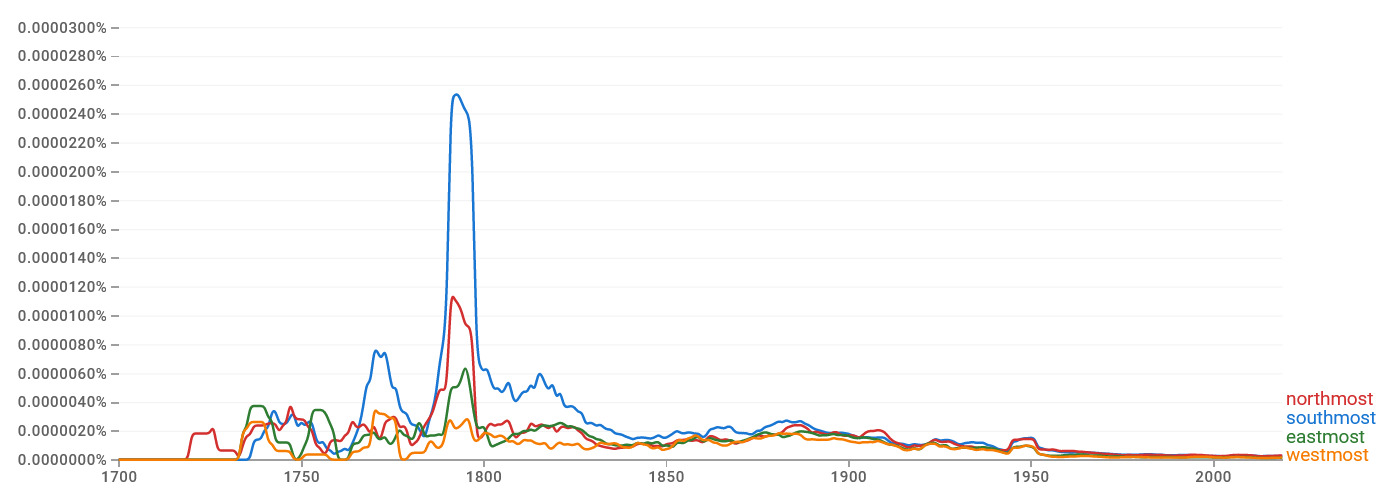
Y-axis: 1 vertical unit = 0.000002% = 2*10-8
First usage (OED): All Old English.
The strange, comparatively huge, surge in the popularity of "southmost" between around 1788 and 1803 (which is certainly real; the links to Google Books include many instances, mostly about India) makes the more recent part of the graph illegible. I therefore include below just the graph from 1820 on, at a scale of 1 vertical unit = 0.0000005%. The surge for "southmost" in 1788-1803 --- at the height of its popularity "southmost" was almost (70%) as popular as "southernmost" --- is mysterious.

Y-axis: 1 vertical unit = 0.0000005% = 5*10-9
************************************************************************
************************************************************************
************************************************************************
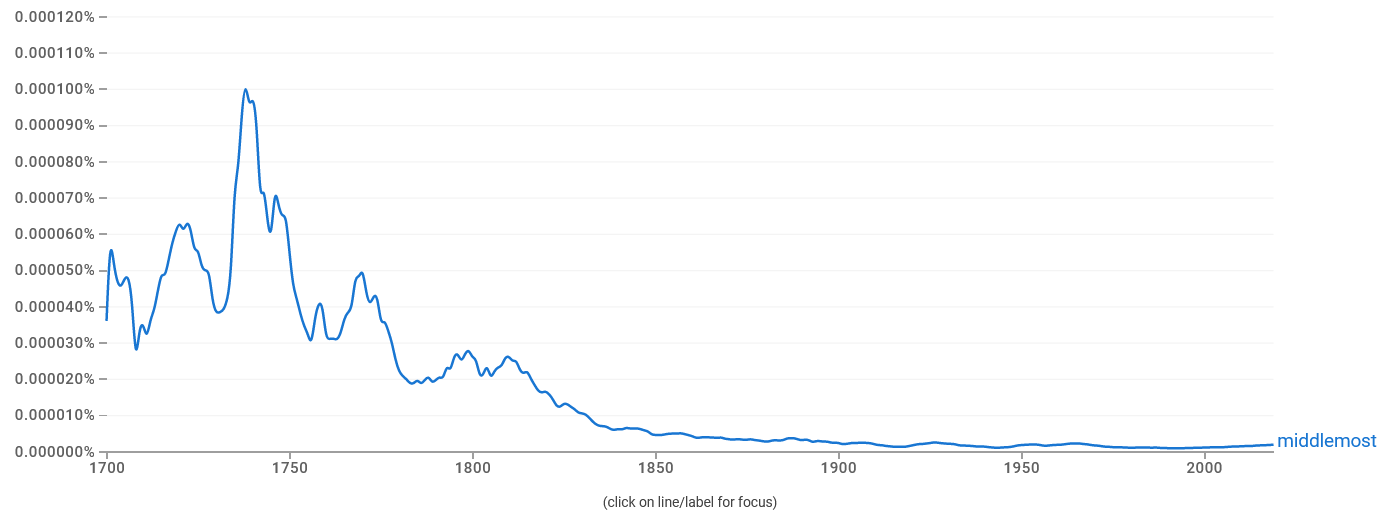
Y-axis: 1 vertical unit = 0.00001% = 10-7
First usage (OED): "middlemost" 1400.
************************************************************************

Y-axis: 1 vertical unit = 0.000002% = 2*10-8
First usage (OED): "midmost" Old English
************************************************************************

Y-axis: 1 vertical unit = 0.0000002% = 2*10-9
First usage (OED): "centremost" 1812. The OED does not have a separate listing for the American spelling.
************************************************************************
************************************************************************
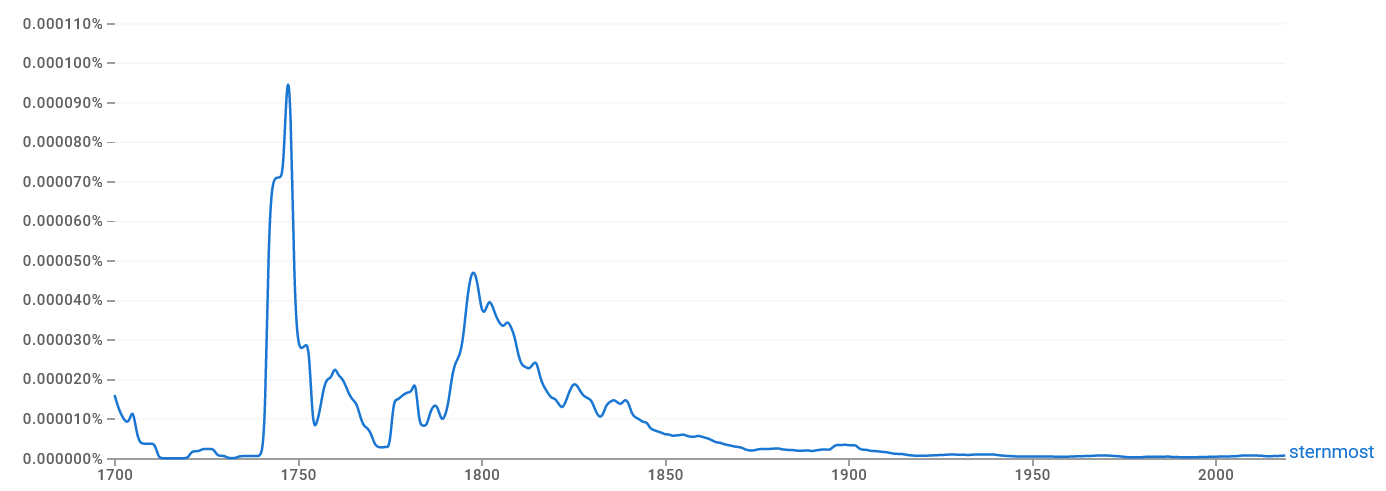
Y-axis: 1 vertical unit = 0.000010% = 10-7
First usage (OED): "sternmost" 1622.
************************************************************************
************************************************************************
************************************************************************
This is very strange. Why, except for one isolated quote in the OED from 1663, were these terms not coined until the early 1800s? (The Google Ngrams graph shows some isolated earlier bumps, but those may be glitches. No information seems to be available about them.) Why did they remain barely in use until the early 1950's, when they took off?

Y-axis: 1 vertical unit = 0.000005% = 5*10-8
First usage (OED): "rightmost" 1663. However the second quotation in the OED is from 1814, so that may have must been an isolated coinage that did not get adopted. "leftmost" 1837.
************************************************************************
************************************************************************
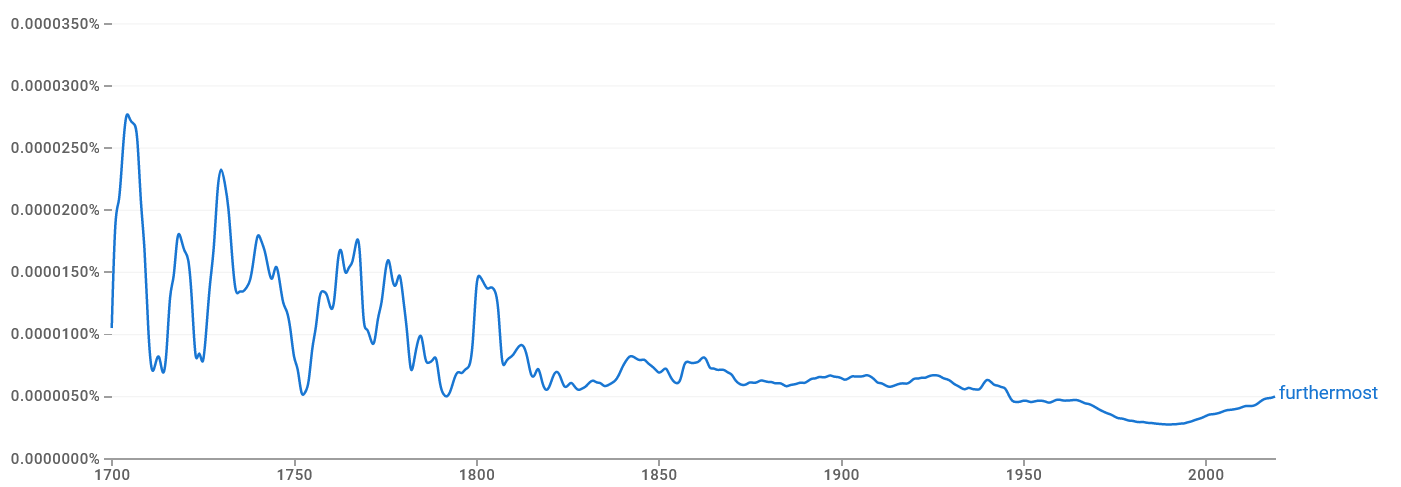
Y-axis: 1 vertical unit = 0.000005% = 5*10-8
First usage (OED): "furthermost" 1400.
************************************************************************
************************************************************************
************************************************************************

Y-axis: 1 vertical unit = 0.000001% = 10-8
First usage (OED): "northwesternmost" 1790. The OED conflates the hyphenated and unhyphenated forms.
I separate out "northwesternmost" from the other three mixed directions, because of the huge bulge between 1815 and 1850. I have no idea what is the explanation. It does not seem to have been about the American Northwest, as one might guess; Google Books shows references to "the northwesternmost head of the Connecticut river", "the northwesternmost boundary of the county of Northumberland", "the northwesternmost point of the Lake of the Woods" and so on.
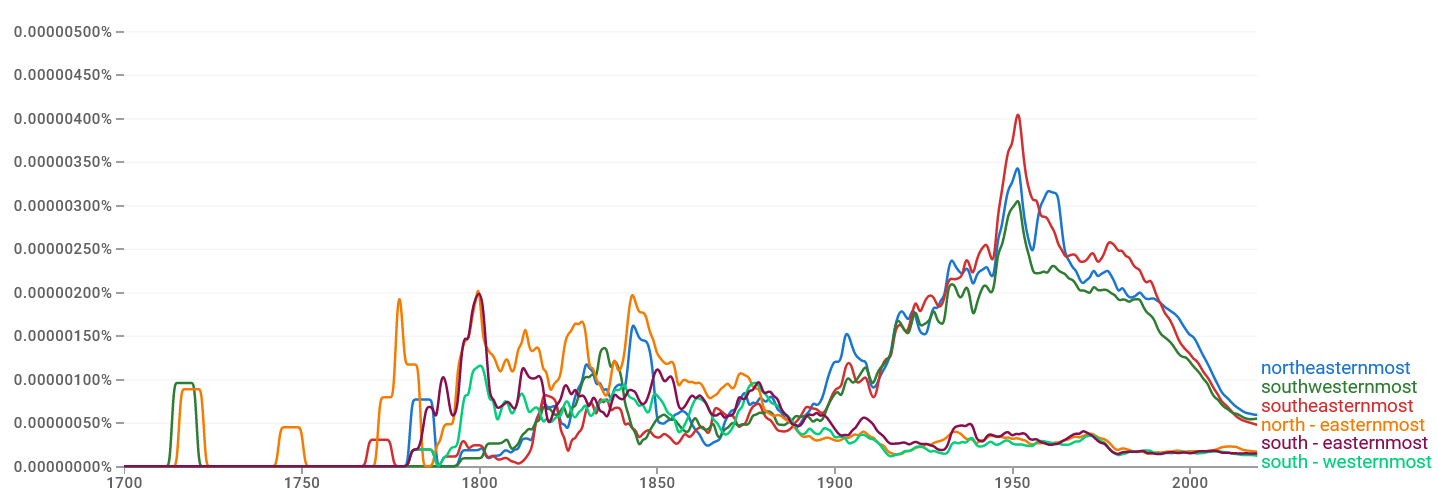
Y-axis: 1 vertical unit = 0.0000005% = 5*10-9
First usage (OED): "southeasternmost" 1760, "southwesternmost" 1773, "northeasternmost" 1784.
The hyphenated and unhyphenated forms were roughly equally common until about 1900, when the unhyphenated form began to dominate. Interest in the superlative of these directions increased steadily until 1950 but have sharply declined since. The graph for the basic form of the direction ("northeast") shows a similar pattern though the peak occurs in about 1915 and both the rise and decline are less steep.
************************************************************************

Y-axis: 1 vertical unit = 0.000001% = 10-8
First usage (OED): "aftermost" Old English.
************************************************************************
************************************************************************
************************************************************************